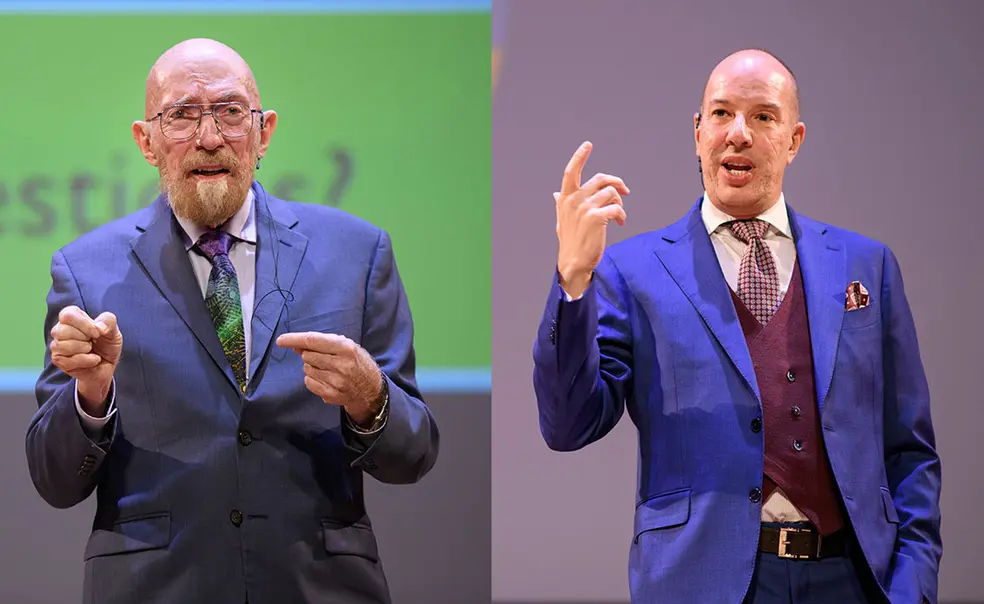Alumni Day 2020: Inspiring Minds
Speakers share how their careers and their values were shaped by Princeton
Alumni Day award winners invariably give thanks to the people who made their accomplishments possible, and this year, their words of appreciation reached more broadly than usual.
Nobel laureate Kip Thorne *65, the James Madison Medalist, shared gratitude for his Princeton mentors, generations of students and postdocs, and his extended scientific family at the Laser Interferometer Gravitational-Wave Observatory (LIGO), which includes some 1,000 researchers from 15 nations.
American Civil Liberties Union executive director Anthony Romero ’87, the Woodrow Wilson Award winner, praised his family, his teachers, Princeton friends, and the thousands of people at the ACLU who have committed themselves to public service over the past century. “No one does anything meaningful or influential alone,” he said.
Romero also pointed out the irony of receiving Princeton’s highest honor for undergraduate alumni. “There’s a good chance that Woodrow Wilson [1879] is right now spinning in his grave like an Olympic figure skater as an award in his name is bestowed on the executive director of an organization literally established to oppose the xenophobic, anti-immigrant, flagrantly unconstitutional Palmer Raids that he oversaw and engineered,” he said, referring to the Wilson administration’s efforts to arrest and deport suspected leftists in 1919 and 1920.
Romero praised the students of the Black Justice League, whose sit-in at Nassau Hall in November 2015 sparked a reexamination of Wilson’s legacy on campus. Some would prefer to have Wilson’s name removed from the award, he said, and others might wish that an ACLU leader would refuse to accept the honor. But Romero viewed the occasion as an opportunity to “reckon with the past,” including his own growth as an undergraduate and the moments in history when the ACLU did not fully live up to its principles.
Romero was not the only honoree to call out the namesake of an Alumni Day award: At the luncheon in Jadwin Gymnasium, Emma Coley ’20, one of the Pyne Prize winners, spoke about Moses Taylor Pyne 1877’s fortune and its ties to slave labor in the sugar trade, citing research from the Princeton & Slavery Project. Coley shared Pyne Prize honors with Ben Press ’20.
Nearly 1,000 alumni and guests returned for the Feb. 22 Alumni Day festivities, which featured talks about mathematics in biology, innovation and entrepreneurship, and navigating college admissions. Alumni also gathered for the annual Service of Remembrance at the University Chapel.
In his address at Richardson Auditorium, Romero shared his story of coming to the University from humble circumstances. Neither of his parents had finished high school before moving to New York from Puerto Rico. Romero spent part of his childhood living in a housing project in the Bronx, and when he was admitted to Princeton, he said, his guidance counselor told him not to come because he wouldn’t fit in. At first, the University felt “like a foreign country whose language I barely understood,” he confessed, but he was grateful for the opportunity to learn, grow, and be humbled.
Romero concluded with a call to action, encouraging all Princetonians to find the joy and rewards of public service. “Being in service isn’t something that can be outsourced — it can’t be delegated,” he said, citing Wilson’s own belief that “there is no higher religion than human service.”
Thorne, a professor emeritus of theoretical physics at Caltech, devoted his lecture to “adventures in inspiration” and the area of physics that he calls “the warped side of the universe” — black holes, wormholes, singularities, and gravitational waves.
Inspiration, Thorne said, was “the most important thing I got from Princeton.” It came from towering faculty members such as John Archibald Wheeler. Thorne recalled his first meeting with Wheeler, in which “he gave me a personal, 90-minute lecture, in the form of a conversation,” explaining his theory of the “fiery marriage” between general relativity and Einstein’s laws of warped spacetime. As a graduate student, Thorne also was enthralled by the experimental work of Professor Robert Dickie, a pioneer in the field of experimental gravity.
Thorne shared slides and animations to explain the foundations of LIGO, the project that draws on more than four decades of his work in theory and research. Developing a tool to detect gravitational waves, he said, was the best way to explore the warped side of the universe, since gravitational waves and black holes are made from the same thing — warped space and time.
LIGO’s first detectors were completed in 1999, but it wasn’t until 2015 that the project successfully detected gravitational waves, from an instance of two black holes spiraling together and merging — a finding that made headlines around the globe and helped earn Thorne a share of the 2017 Nobel Prize in physics. Now, researchers are detecting gravitational waves on a weekly basis, he said. There’s even a smartphone app to alert team members and the general public to the latest event.
While citing those who inspired him, Thorne also spoke about his efforts to inspire others, sometimes through nontraditional means, such as consulting on the science-fiction film Interstellar (and writing a companion book about the science behind it). His latest project is a book of physics-inspired poems, illustrated by the painter Lia Halloran.
Fielding audience questions, Thorne was asked whether he believes in the existence of extraterrestrial life. He shared a story about a meeting with Stephen Spielberg, in which the director asked a roomful of Caltech physicists if they believed there was intelligent life somewhere in the universe that is more advanced than we are. “Every hand went up,” Thorne said. “That is certainly my view — it’s very likely. But it’s very unlikely that any of them have come to Earth.”












No responses yet